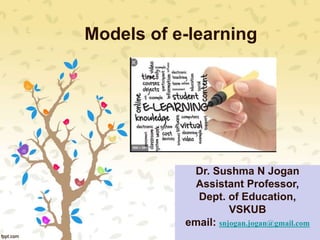
Models of E-Learning Explained
- 1. Models of e-learning Dr. Sushma N Jogan Assistant Professor, Dept. of Education, VSKUB email: snjogan.jogan@gmail.com
- 2. What are models of e-learning? • There are different types of models of e-learning based on which the term e-learning is developed and came into existence. • Engelbrecht (2003) states that e-learning models began as mere replication of classroom instruction, but have evolved to those that integrate technology and pedagogy. • There are early models focused on the role of technology in providing content, access and electronic services. • More recent models have emphasized the instructional design of the e- learning instruction. • Not only models there are theories to understand e-learning in a better way.
- 3. 1. Demand Driven learning model
- 4. • This model was developed in Canada as a Collaborative effort between academics and experts from private and public industries. • Developed by MacDonald et al. 2001 • It discusses the LMS, contents and services. • The technology is a support or a tool to achieve the desired learning outcomes. • Primary goal is to encourage academics to participate actively in teaching process. • Also highlights the importance of realizing the changing needs of learners and instructors as well as pedagogical changes. Demand Driven learning model
- 5. 2. Strategic e-learning model
- 6. • Contributed by Weinstein • Focused on students as active, self-determined individuals who process information and construct knowledge. • It explores the need of online learners experience and their problems Which they may have never encountered in traditional environments. • The model has the learner at its core and around the core are 3 interactive components: Skill, Will and Self-regulation. • This instrument provides a diagnostic instrument for e-learning researchers, system designers, curriculum developers and instructors to evaluate. • Further it can be used to profile how students interact with the complex e-learning environments when they are involved with internet-based learning. Strategic e-learning model
- 7. • It enhances all different models into one and applies synchronously and asynchronously to E-learning implementation. • Successful implementation of E-learning can only be achieved by joining three interrelated components. • Funnel model takes curriculum or materials development together with beneficiaries‘ analysis when implementing E-learning. • The Funnel Model pays attention to usability and availability of technology to ensure that technology matches instructional design of the teaching materials. • The Funnel Model also incorporates administration, which encompasses governance and finance, being aware that sustainability of any system depends on its management. 3. (Funnel model) for implementing e- learning
- 8. 4. e-learning technology acceptance model (TAM) • The popular model in implementing e-learning technology is this model. • It is based on the premise that both student’s perception of e-learning use and its perceived usefulness affect users’ intention. • it focuses on the use of e-learning technology for content management. • It has 3 components helps to cover the weakness of theory based model. • It is developed by Davies in 1989
- 9. Community of inquiry model • Developed by Garrison and Anderson 2003. • Its purpose is to provide a framework to support an educational experience. • A community of inquiry provides the environment in which learners can take responsibility for and control their learning through interaction. • Cognitive presence: extent to which learners are able to construct- HOT skills. • Social presence: the ability of participants in a community of inquiry to project themselves socially and emotionally . • Teaching presence: the design, facilitation and direction of cognitive and social processes for the purpose of meaningful and educationally worthwhile learning outcomes.
- 11. Laurillard’s conversational model - 2002 • The model is developed from the work of VYGOTSKY 1962 (Social interaction) • The focus is on the student learning and the characteristics of the design development and delivery that ensure an effective course. • Laurillard suggests that learning is based on the teacher helping the student to conceptualise the teacher’s model of the subject through discussion and negotiation. • This model is one of the helpful model for teaching and learning process.
- 12. Laurillard’s conversational model - 2002
- 13. Laurillard’s conversational model - 2002
- 14. Laurillard’s conversational model - 2002
Notas do Editor
- https://participativelearning.org/mod/url/view.php?id=517
- Source: https://slideplayer.com/slide/14606030/
- Source: https://slideplayer.com/slide/14606030/
- Source: https://slideplayer.com/slide/14606030/
- Source: https://slideplayer.com/slide/14606030/
